Motorcycle communication systems have changed the riding game, allowing riders to communicate with one another, answer calls, hear GPS coordinates, or just soak in some road tunes. But no matter how convenient these systems have been, there was often something lacking in the audio quality department. Cardo aims to change that with its new partnership with JBL.
The recent news is that Cardo has developed an audio set with speakers that have been fine-tuned by the experts at JBL. The promise is deeper bass notes, more natural sound overall, and clearer voice communication. These new speakers are designed to fit into existing Cardo units and the Cardo app will allow riders to choose from three output profiles.
We were thrilled to hear the news but wanted to know more about the development of the new speakers, so we got in touch with Bruce Ryan, director of engineering at Harman/JBL. He’s been with the company for close to two decades and has loads of experience outfitting high-end cars with quality Harman/JBL kit. Prior to that he worked on race cars for Nissan and Toyota. He’s no stranger to optimizing performance, whether it’s in the racing realm or audio realm.
According to Ryan, JBL’s decades of experience developing headphones factored greatly in the approach to the new Cardo units.
“It comes down to the size of the speaker itself, the materials in the speaker, and some subtleties in design, magnet design, and the like,” he explained. “The goals were to provide the widest frequency response that’s possible, so very high highs, and be able to get down way low in the bass.”
Unfortunately, one of the primary issues of reaching those low-down bass notes is how the speaker surrounds the ear. It’s a tricky problem to solve even when designing standard headphones, and one that was particularly troublesome within a motorcycle helmet.
“All the speaker is doing is moving air. So if it has to move air in a large area, it can’t do that very efficiently, but if it’s got a small, sealed area volume but a smaller headphone, it can move a lot of air in that small volume. You’re able to reproduce the low-frequency bass notes.”
Cardo wasn’t too far off the mark in terms of the design of its acoustic element, Ryan explained, so JBL engineers were able to take that base and begin to introduce improvements.
“We made subtle changes to that driver itself. We made some recommendations on foam geometry, on ways to fit it in the helmet. Modern helmets are getting better and better when it comes to how it fits around the ear and where you can put the actual speaker.”
However, even a perfect speaker isn’t going to perform as well as it could if it’s not properly positioned.
“We found that a lot of people didn’t spend the time to get the speaker centered over their ear,” Ryan explained. “They would just put it in where it’s convenient in the helmet, and a lot of times that’s pretty far off from the opening of the ear. It’s something that’s fairly straightforward, but most people don’t realize that that can have a huge effect on how great the sound is just by placing it in the helmet.”
He recommends taking the time to get the speaker as close to over the ear opening as possible, for these speakers, or any speakers for that matter. A few moments’ adjustment before a ride can make all the difference.
To help mitigate the audio quality loss, however, JBL continued its development.
“What we did was once we were able to figure out what the variables were, the placement, how close to the ear, and all of that, we went to our test lab here where we have actual mannequins that are instrumented with real, rubber, human[-shaped] ears and ear canals, ear drums, and microphones, and did a lot of experiments. We get realistic results, frequency response results, that mimic what a human being would hear. So we’re able to make very small changes and measure those immediately. We spent several months in our chambers. We were able to get a good fitting, very wide frequency response driver.”
Engineers continued to adjust the elements that affect audio quality as well, minimizing distortion, minimizing listening fatigue, and optimizing the audio path through all the electronics.
“Fortunately Cardo has done a very good job of architecting, designing, and building their audio path. So we came to the conclusion quickly that we just needed to make some electronic software changes,” Ryan explained.
The approach, aimed at improving all these elements, led JBL to develop selectable audio presets to meet a broader range of needs.
“The actual electronic changes to the music profile compensate for different helmet fits, different ear positions, and the like. Over the months we developed those profiles, which Cardo placed into their app. So you can sit there on the bike with your helmet in position, play music, and then choose between the different settings that sound best to you.”
As for the actual hardware though, there’s not a whole lot changed from the previous Cardo elements. The secret is in how those elements are used.
“You can look at it this way,” Ryan said when asked about any significant hardware changes. “I’m not a chef, but if I was putting a cooking contest against Wolfgang Puck or one of the top chefs and we were both given exactly the same ingredients and were asked to build food for someone, a dish, the results would be tremendously different. My dish wouldn’t taste nearly as good or look the same as Wolfgang Puck’s. A lot of people might look at the final product and say, ‘Wow, they all look the same.’ But it’s the small subtleties. We all use basically the same materials and the like, but it’s the small subtleties that are almost invisible that give you that final difference.”
And this is just the tip of the iceberg. JBL and Cardo’s relationship is slated to last for some years going forward.
“We’ve got another research program that we’ve been doing for about six months now and it will continue. That’s going to be the next level in rider comfort, in lessening rider fatigue, and speech delivery. So enhancing the communication, the clarity of the voice, and the like. That’s kind of where our research is going now.
“We’ve collected helmet samples from all the helmet manufacturers around the world. We’re doing a general survey regarding how quiet they are and how well they fit around the ear and the like; there is a huge difference between the manufacturers. There are some that are doing an extremely good job in design when it comes to wind noise and acoustic comfort and the like. So that’s part of the other research. So we’re such an integrated partner with Cardo now that we’re actually going out and helping the overall industry move the bar up when it comes to rider comfort and communication clarity.”
Harman/JBL has decades of experience working within other industries, so this is somewhat familiar territory. Harman and JBL equipment can be found in everything from phones and laptops to concert speakers and televisions. The level of development in motorcycle communication and information delivery devices, however, is still in its budding stages and has a lot of room for improvement.
“We have a lot of augmented-reality technology too with some of our other products,” Ryan explained after we asked in reference to what the future could look like in this segment.
“I can see 10 years from now, or even five years from now, small head-up displays in the helmet that actually ghost in information over the road. So as you’re looking out the visor I could be getting information both on where I’m going, where I need to turn, so it’s actually imprinted on the road that I’m looking at. I can get information about my bike. What’s the rpm, what’s my gear, what’s my speed, fuel level.
“Anything that the bike is gathering can be easily transmitted into the Cardo system of the future, and that can be presented to yourself as well as any of the other riders you’re with. More natural voice communication. Cardo has been a leader in that already in that I just speak to the Cardo system. That’s a great functionality. I don’t have to touch buttons. I don’t have to do that. So an extension of that, I not only can converse with my Cardo system and have it do functions, I can get access to my cellphone functionality. Things like when I get a call coming in, it could say, ‘Hey, your wife is calling.’ And you could just respond back and say, ‘Hey, could you just relay the following message?’ And it dictates that and it can send that out directly. So a bunch of hands-free communication, both visually and through the speakers.”











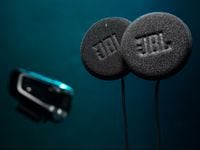
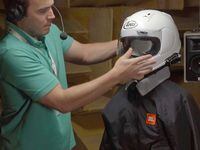
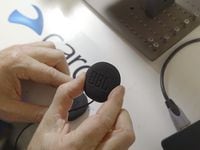
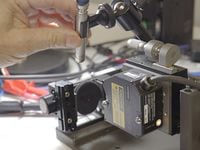
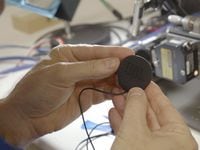
/cloudfront-us-east-1.images.arcpublishing.com/octane/TNOU5DNE2BC57MFPMGN2EIDXAM.jpg)
/cloudfront-us-east-1.images.arcpublishing.com/octane/GTCXACQGJ5HAPDTGWUQKDEH44E.jpg)
/cloudfront-us-east-1.images.arcpublishing.com/octane/S35YGSEMEZB4BLTDJTSZPF4GLA.jpg)
/cloudfront-us-east-1.images.arcpublishing.com/octane/5UOT6HPX2JFMRJAX6EH45AR4MQ.jpg)
/cloudfront-us-east-1.images.arcpublishing.com/octane/OKWOJWAKP5EP3OACCRRWPCIX2Q.jpg)
/cloudfront-us-east-1.images.arcpublishing.com/octane/2WF3SCE3NFBQXLDNJM7KMXA45E.jpg)
/cloudfront-us-east-1.images.arcpublishing.com/octane/G4MG6OUCJNBSHIS2MVVOTPX65E.jpg)
/cloudfront-us-east-1.images.arcpublishing.com/octane/IIGGWFOTOJGB7DB6DGBXCCMTDY.jpg)
/cloudfront-us-east-1.images.arcpublishing.com/octane/QSTCM6AVEZA5JJBUXNIQ3DSOF4.jpg)
/cloudfront-us-east-1.images.arcpublishing.com/octane/U4I7G625B5DMLF2DVIJDFZVV6M.jpg)
/cloudfront-us-east-1.images.arcpublishing.com/octane/B6XD6LS6IVCQPIU6HXDJSM3FHY.jpg)
/cloudfront-us-east-1.images.arcpublishing.com/octane/ICL63FEDDRDTTMINYICCEYGMDA.jpg)
/cloudfront-us-east-1.images.arcpublishing.com/octane/FCGZHQXRBZFLBAPC5SDIQLVF4I.jpg)
/cloudfront-us-east-1.images.arcpublishing.com/octane/WNOB6LDOIFFHJKPSVIWDYUGOPM.jpg)

/cloudfront-us-east-1.images.arcpublishing.com/octane/X33NU3E525ECRHXLNUJN2FTRKI.jpg)
/cloudfront-us-east-1.images.arcpublishing.com/octane/6KKT5NNL2JAVBOXMZYS5ZO76YA.jpg)
/cloudfront-us-east-1.images.arcpublishing.com/octane/J5RKG5O455GMPGQRF2OG6LRT7A.jpg)
/cloudfront-us-east-1.images.arcpublishing.com/octane/GX2CIZKQVRH2TATDM26KFG2DAE.jpg)
/cloudfront-us-east-1.images.arcpublishing.com/octane/ZWIDYSAKQZHD5BHREMQILXJCGM.jpg)
/cloudfront-us-east-1.images.arcpublishing.com/octane/CYUHJZCTSJCH3MRAQEIKXK7SCQ.jpg)
/cloudfront-us-east-1.images.arcpublishing.com/octane/LKOFINY56FCXJCANJ5M7ZDQUBY.jpg)
/cloudfront-us-east-1.images.arcpublishing.com/octane/4NBPDACMWJH63JQYJVK3QRBDZI.jpg)
/cloudfront-us-east-1.images.arcpublishing.com/octane/KKHQHRR3FJGX7H2IPU6RALMWG4.jpg)